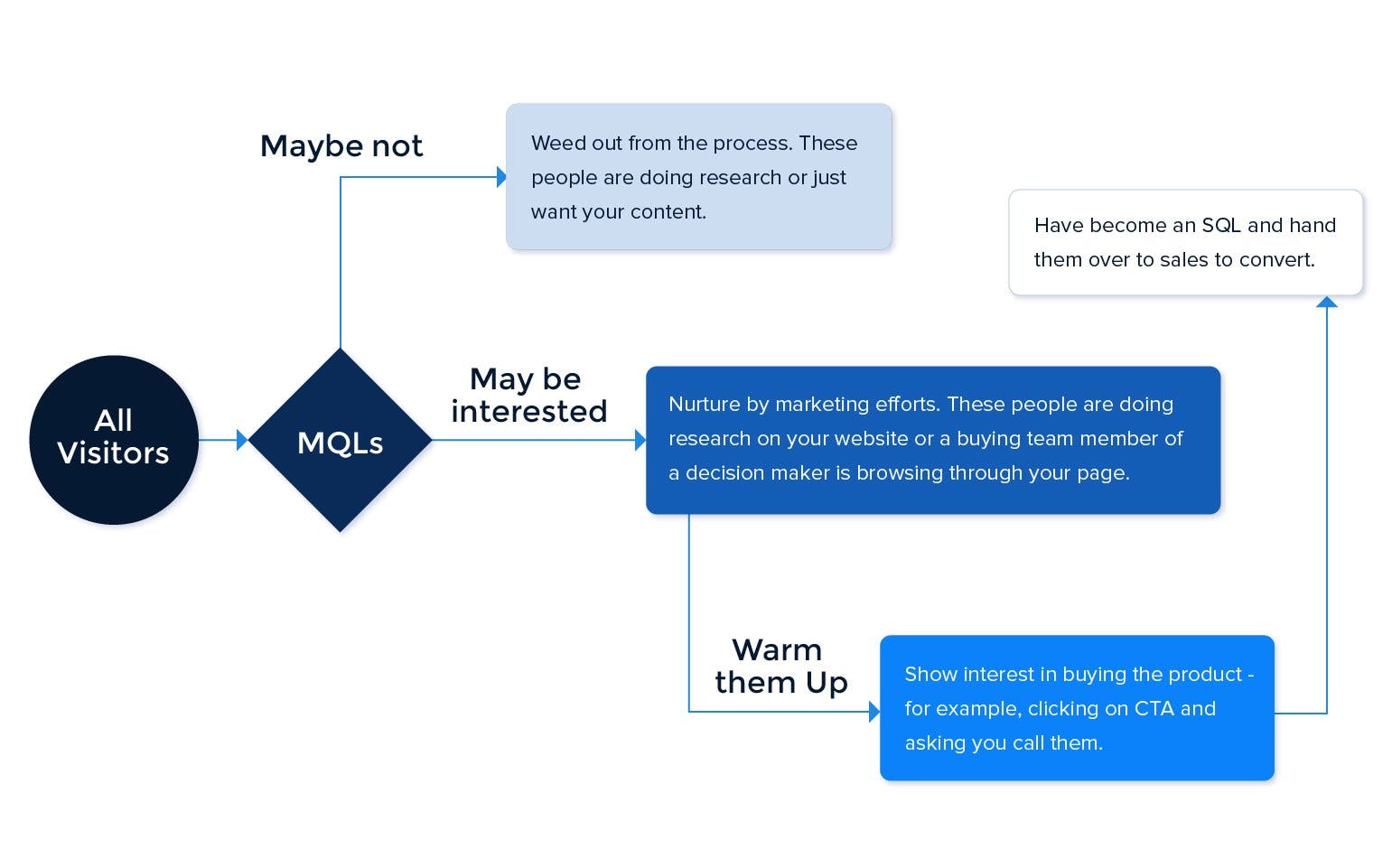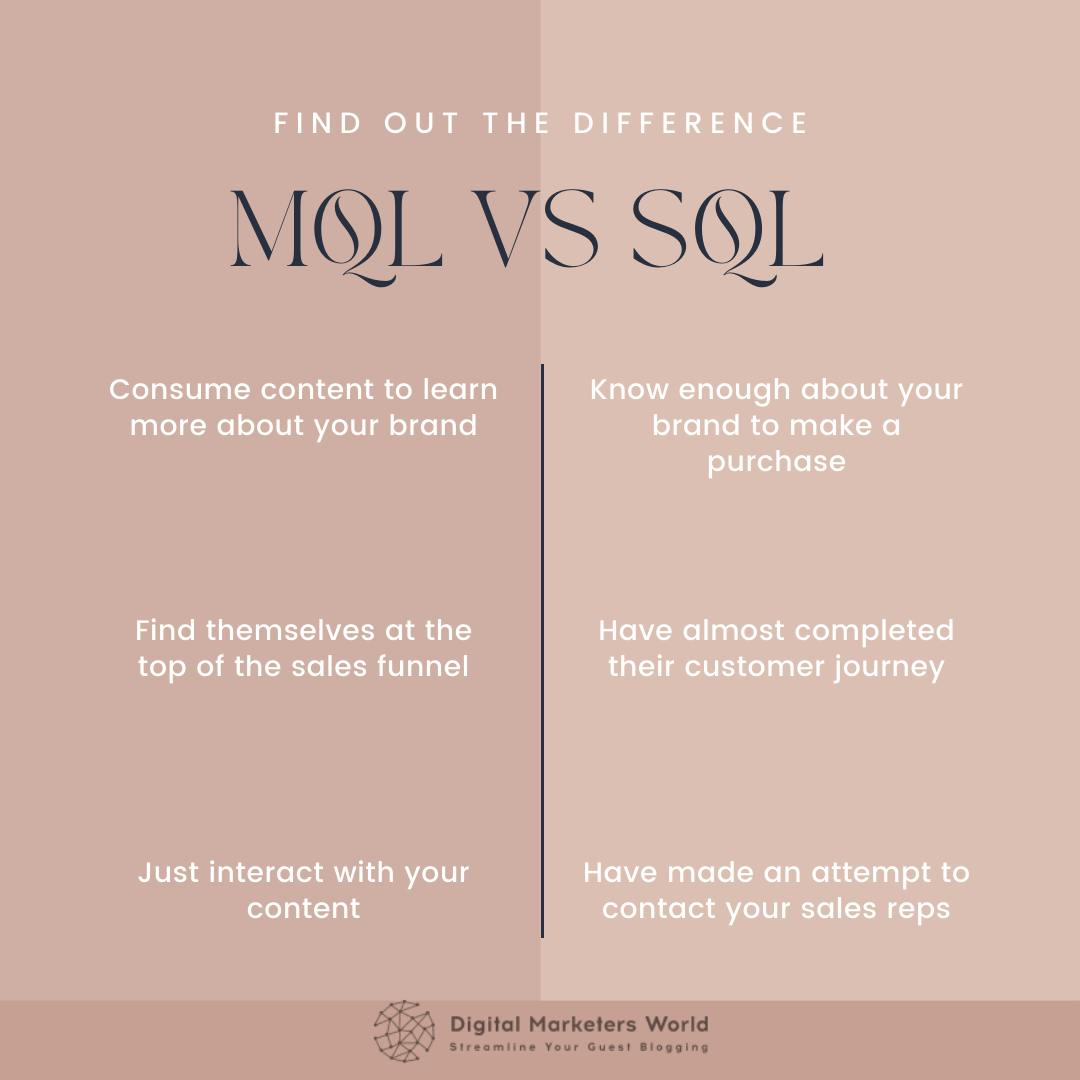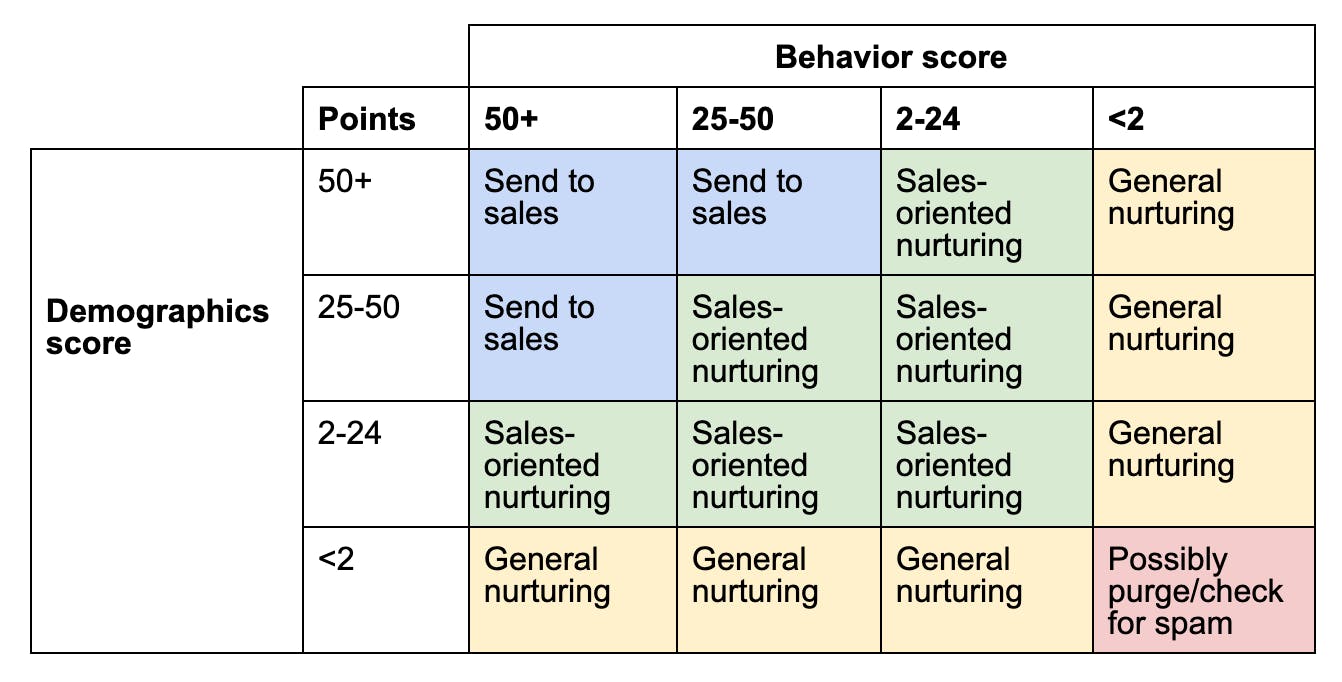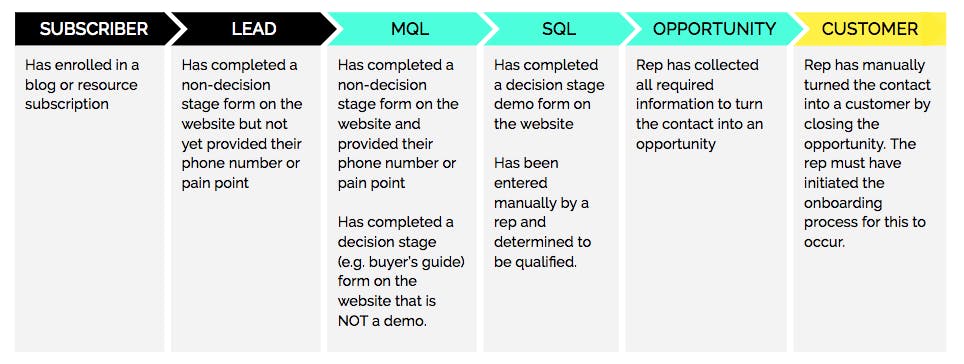Marketing Qualified Lead (MQL): a comprehensive guide
Mar 21st, 2023

Contents
What is an MQL?
How to identify and qualify marketing leads?
Transferring leads to the sales team
Acquiring additional sales might be a challenge for your business. You might be disappointed if you attract a constant stream of leads who do not convert into sales. The sales team might also be dissatisfied because they are spending a lot of time attempting to close deals with leads who are unable to purchase your product.
Therefore, the most crucial step in the sales process is typically identifying sales prospects with the highest purchase intent. Once you implement a smooth lead qualification process, you can improve the strategy for converting MQLs to SQLs.
In this article, we will discover how to distinguish unqualified leads from MQLs who are almost ready to purchase your products and services. Let us explore how MQLs fit into the broader sales process, how to identify this type of leads, and the difference between MQLs and SQLs.

What is an MQL?
A marketing qualified lead or MQL is a prospective client who has been evaluated by the marketing specialists and meets the requirements to be forwarded to the sales team. This lead has expressed interest in the brand’s products and is likelier to become a customer. In frequent cases, an MQL is a potential client who engages with a company by providing personal details, adding products to a shopping cart, downloading content, or repeatedly visiting a website.
Although most businesses view people who visit their website and communicate with them via social media as potential customers, more signals are needed to categorize them as MQLs. Marketing specialists typically identify MQLs using lead intelligence which is frequently supported by closed-loop analytics. In addition, a marketing team nurtures leads that are most likely to turn into customers based on behavioral scoring and firmographic attributes, such as business size and ad spend.
MQLs could be more interested in your product than other leads, but they are not ready to decide yet. However, they are more likely to respond favorably to any brand message encouraging them to purchase a product. If MQLs move further down the sales funnel, they eventually become SQLs and later paying clients. So let us consider the differences between marketing qualified and sales qualified leads.
MQL vs SQL
Although the terms sound similar, these two categories of leads are at different stages of the buying process. An MQL is at the beginning of the buyer’s journey. They are exploring the possibility of using a company's content to address their business issue. A sales qualified lead, in contrast, is at a later stage of the buying process. They have specific questions and are ready to talk to your sales department. SQLs may have chosen to enter your sales funnel independently, but this is frequently the result of the company’s marketing efforts.
The critical difference between MQLs and SQLs is the purchasing intent. Therefore, it is the primary indicator for digital marketers when determining whether or not to move a lead on to sales, despite the additional factors determining whether a lead is classified as marketing or sales-ready.

You can determine whether a lead intends to purchase through specific actions. For example, sales qualified leads can download trial software, ask for a demo, visit your pricing page, and request contact from the sales team. On the other hand, marketing qualified leads would provide basic contact information, download gated content, attend webinars and sign up for email newsletters.
Understanding these differences will help you effectively manage and devote the company’s resources accordingly. Further, we will pay greater attention to the methods of identifying and qualifying MQLs and explain the strategy step-by-step.
How to identify and qualify marketing leads?
Your company may not have a very fine-tuned lead generation process. For example, your sales team can emphasize generating as many leads as possible instead of focusing on the right type of leads. Therefore, you need to qualify leads before marketing the products to them.
Analyze customer history
The first step to identifying MQLs is to examine customer history. You can more accurately forecast who of your current leads will become customers after understanding how past consumers behaved before purchasing. When analyzing past clients’ purchasing histories, consider the crucial patterns.
To make sure the analysis is accurate, you can use the attribution model. This strategy enables marketers to examine and assign credit to marketing touchpoints at the precise stages of the customer journey, from online product research to actual purchase, including all actions in between.
Conduct in-depth research
Use Google Analytics to learn details on the customers’ activity on your website, including information about devices, demographics, interests, preferences, as well as the pages they like to visit. You can also use social media to get more demographic and psychographic data about your potential customers.
Facebook Audience Insights may help you understand leads’ requirements. In addition, you may learn important details about your possible customers, such as their job, hobbies, and concerns, by looking through LinkedIn pages. You may also browse the website of a potential client's company to learn more about their objectives, principles, and offerings while also gathering some contact details.
As a result, you will discover a strong trend. For example, you may notice that the majority of your customers visited your website pricing page before signing up for email notifications or clicked through the emails from your marketing outreach campaign before asking for a demo. Finally, you will be able to create a straightforward buyer's journey and use it as a foundation for your lead scoring and qualifying processes.
Create your ideal buyer’s profile
After reviewing your buyers’ history, it is time to build a profile of your ideal customer or ICP. Therefore, you need to identify the pain points and business issues they are trying to solve with your product or service. Then find answers to the following questions. Who are the consumers of your goods? Do you need to consider any typical demographic factors? What attributes do the ideal buyers possess? What issues or difficulties do they encounter? What industry do they work in?
A lead's behavior and interaction with your marketing materials comprise their behavioral factors, while the demographic characteristics of the online lead include their income, occupation, industries, age, and gender. When considering behavioral factors, you need to analyze how sales prospects react to your marketing activities. For instance, if a lead looks at your pricing page before subscribing to your blog and visits your website more than once, these are signs that they could be a potential client.
Then you should pay attention to demographic factors. For example, you can qualify leads by taking into account the location. If your business offers handmade shoes to customers in Europe and North America, you can exclude potential customers based in Africa or Asia.
Speak to your sales team
The next step is to talk to the sales representatives before marketing qualified leads are sent to them. Every day your sales team has direct contact with potential customers, so they have a lot of insights you can use in identifying and qualifying MQLs. Set up a meeting with your team to go through the sales process and identify the typical characteristics of leads who convert. It will help you gather enough information about the types of leads you want to attract.
At this stage, you should also decide when a lead is ready to contact a sales team. You need to discuss aspects like the lead’s background and level of decision-making authority. Moreover, you should talk about the marketing materials your sales team can use to identify a potential MQL, the particular characteristics required to classify someone as MQL, and the challenges or pain points a potential customer can experience to be qualified as MQL.
Ask your sales team to collect feedback from each customer. Sales representatives should discover how leads have learned about your business, what motivated them to purchase your products, and what sets your business apart from the competition. Besides providing feedback from the prospects, your sales team can also share their impressions from working with customers. In addition, ask sales representatives about the marketing materials they need to work more effectively. These could be white papers, email templates, or sales scripts.
Implement lead scoring
One of the most useful methods to qualify leads is lead scoring. Although each company has a unique approach to evaluating and scoring leads, one of the most popular methods is to build a lead rating system using information about previous customers. The lead scoring model implies assigning each lead a numerical score. A lead with a higher score is more likely to convert.
You can use various characteristics to score leads, such as their interaction with your website or the quality of the information they have provided to you. With lead scoring points, you can model the buyer’s journey, prioritize leads and improve your conversion rates. Many companies evaluate leads using the following attributes: demographic data, company information, online behavior, email engagement, and social media engagement.

For example, if you are a B2B company, you could be more interested in doing business with organizations that fall into a particular category. By asking questions about the company’s size, type, or industry in your landing page forms, you can identify the types of leads who are a good fit for your business. Then, if a lead falls into your target market, you can give points to the company while subtracting points from leads who are different from what you are searching for.
If a lead has signed up to receive emails from your company, you cannot be certain how interested they are in purchasing from you. However, you can analyze open and click-through rates to have a clearer picture.
Run outreach campaigns
Without initial contact with prospects, sales professionals cannot obtain certain details about potential customers. At this stage, sales representatives typically ask the following questions. What problem are you trying to solve? Do you currently have an alternative solution to this issue? What objectives do you want to accomplish with this solution? What time frame suitable for implementation? Who would make the final choice about this purchase? What is the estimated budget for this solution?
These questions concern budget, timeline, and corporate hierarchy. This is done to make it easier for the prospect to provide the sales department with information on leads’ day-to-day activities and business operations.
Use SPIN during outreach
Neil Rackham coined the term SPIN in 1988. It represents Situation, Problem, Implication, and Need-payoff. The situation stands for the current state of affairs; the problem is the specific issue you can help resolve; the implication is the consequences of this issue for the prospect; the need-payoff relates to the importance of putting your solution into practice.
A salesperson should ask about these four topics in a specific sequence. It helps you investigate the existing circumstances and the issue your lead is facing. Additionally, your sales representatives should identify the root causes of the customer needs before demonstrating to prospects why they should buy your product.
Choose the appropriate lead qualification framework
Several frameworks can help you in lead qualification. These frameworks include a formalized set of parameters used by businesses to choose the leads that should be qualified. They entail comparing the lead's data and grading it by the framework's key criteria. The most popular lead qualification frameworks include BANT, CHAMP, GPCTBA/C&I, and ANUM. Further, we will describe each methodology in brief.
BANT is one of the most often used methods for qualifying leads, and it is also the simplest and fastest. This framework focuses on budget, authority, needs, and time. Using this framework, a salesperson can determine whether a prospect satisfies basic and the most crucial criteria. For a lead to be considered, it must meet at least three requirements.
CHAMP is a framework that takes into account challenges, authority, money, and prioritization. Thus, in contrast to BANT, the methodology puts more emphasis on the prospect’s requirements, issues, and pain points. This framework allows you to precisely classify leads and identify unique opportunities. The budget becomes less important if your potential customers know how to solve their problems using your products or services.
GPCTBA/C&I framework is the advanced version of the BANT methodology. It focuses on customers’ needs, characteristics, problems, and plans. The framework considers the following aspects: goals, plans, challenges, timeline, budget, authority, adverse outcomes, and positive consequences.

Finally, ANUM is a methodology that focuses primarily on authority. The framework implies pre-qualification to ensure that prospects fit your ideal customer profile. With this methodology, identifying if the person you are communicating with is a decision-maker will be your top priority. The framework provides characteristics for the lead qualification that include authority, need, urgency, and money.
Frameworks provide companies with a structure to simplify the qualification process. You may quickly find prospects ready to become your clients by using one of them. After this, your task is to transfer MQLs to the sales team.
Transferring leads to the sales team
The transfer between marketing and sales departments significantly impacts whether a lead turns into a customer. If you transfer leads too early, your sales team will waste time on clients who are not ready to purchase or who are a bad fit for your company. On the other hand, if this happens too late, your competitors with better timing are likely to attract your potential clients. Therefore, it is crucial to choose the right moment.
The other critical point is ensuring everyone in your company is on the same page. Thus, sales and marketing teams need to be aware of the signs that a lead is ready for the sales process as well as when and how to transfer leads. Your company should create unique requirements for this process. You can use the following criteria to identify the leads ready for the sales process: jobs, geographies, company revenue, number of employees, and level of engagement.

Sales and marketing teams should collaborate to develop messaging that appeals to the leads and find potential clients with higher purchase intent. The company’s success depends on the sales, marketing, and customer service departments working together.
Evaluating performance at each point of the funnel requires everyone involved to have a common idea of what success looks like. The teams should pay attention to the crucial performance indicators, including customer growth and conversion funnel. Moreover, it is vital to continuously analyze each stage of the sales funnel and make improvements.
Lead qualification is not an exception to the rule that there is always a potential for improvement in the marketing industry. However, the outcomes will be obvious if your marketing and sales departments manage to establish strong working relationships and fine-tune the lead qualification criteria together.
